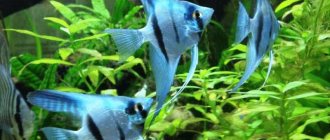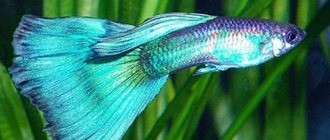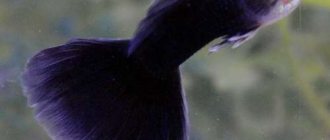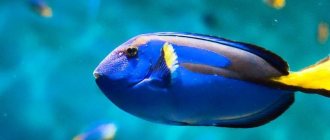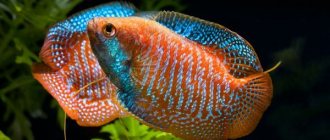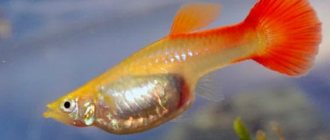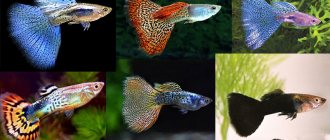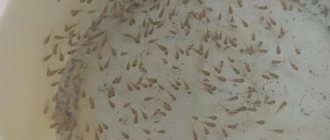Guppy (Poecilia reticulata)
Categories: Guppy
Guppy ( lat. Poecilia reticulata or Guppy) is a freshwater viviparous fish of the Poeciliidae .
Synonym: Millionenfisch .
Guppy is the most popular and unpretentious aquarium fish. In a home aquarium, it inhabits all layers. In captivity, it lives longer and grows larger than in nature. Aquariums most often contain different breeds of guppies or the result of their mixing.
Guppies have pronounced sexual dimorphism - males and females differ in size, shape, and color: The size of males is 1.5-4 cm. The body is slender. Thoroughbred individuals often have long fins. The color is often bright. Males have a specialized organ - the gonopodium - a phallic-shaped anal fin.
The size of females is 2.8-7 cm, with an enlarged abdomen, in the anal area of which eggs are visible. The fins are always proportionally smaller than those of males. Females from natural habitats and many breeds are gray with a pronounced rhombic mesh of scales, for which the species received its name: “reticulum” from lat. - mesh, mesh.
Male (left) and female guppy
Guppy lives in fresh and brackish waters of Venezuela, Guiana, north of the Amazon, in northern Brazil, on the islands of Barbados and Trinidad.
Acclimatized on all continents (to combat the larvae of malaria mosquitoes, they are distributed throughout warm water bodies around the world).
A population of wild guppies constantly lives in the Moscow River, in the area of warm water discharge in Lyubertsy and in other places - apparently, this population originates from fish released by aquarists. In the areas of the Volga cities (Tver, Yaroslavl, Rybinsk, Nizhny Novgorod), self-reproducing populations of feral guppies have been observed in areas where heated water is discharged, as well as in settling ponds of wastewater treatment plants.
The genus Guppy got its name in honor of the English priest and scientist Robert John Lemcher Guppy, who in 1886 made a report to members of the Royal Society in which he spoke about fish that do not spawn, but give birth to live young. After this he was laughed at.
Classification according to the shape of the tail and fins
Guppy breeds are also classified by the shape of their fins. Often the forms are similar to each other. There are 14 forms.
Fantails
The tail is large and wide without sharp ends. The veil on the back is directed downwards.
Fork
Tail with 2 sharp ends. The narrow dorsal fin is located parallel to the body.
Flagtails
The guppy's "skirt" is rectangular with a smooth edge. The dorsal plumage is directed upward, pointed at the end.
Spinetails
The guppy's "fan" is rounded, with "needles" in the center. The dorsal fin is raised and pointed at the end, its length occupies a third of the entire body.
Speartails
The tail resembles the point of a spear, less rounded than in spiny tails and with a smoother transition to pointed central rays. The length of the tail is equal to half the body. The plumage on the back is curved and pointed.
Triangel
Another name for the variety: clipped fantail. The triangular “fan” does not have such a strong swing as that of fan-tailed guppies. The corners are clear and sharp. The fin on the back is wide, raised, ending at the level of a third of the tail.
Round-tailed
The caudal fin is rounded and miniature, the dorsal fin is rounded and shortened. The size of the tail is no more than half the body of the fish.
Double sword
Rounded tail with long outer rays. The guppy has a narrow, elongated fin on its back.
Lyrebirds
The shape of the “skirt” is similar to a lyre. The short dorsal fin is directed upward.
Lower sword
The “skirt” is rounded, with a sword-shaped appendage at the bottom. The plumage of the back is narrow and pointed.
Upper sword
The “sword” is located on top, unlike the previous variety of guppy.
Spadetails
The tail is large, square, and rounded; its length is equal to half the body of the fish. The dorsal plumage is long.
Sharp-tailed fantails
Lush triangular “skirt”. The fin on the back is directed upward.
Veil-tailed skirts
The fins are elongated, not too wide, the dorsal is directed upward.
Feeding the guppy
Guppies are omnivorous fish and require small food of both animal and plant origin. These are mainly plankton (protozoa, rotifers), phylodina (asplancha), crustaceans (cyclops, daphnia, moina, mosquito larvae), coretra (bloodworms), neuston (mosquito pupa), lower plants (chlorella, spirulina), as well as some algae fouling. They tolerate dry food well.
The amount of daily feed is given approximately in the following calculation:
— for one adult male they give 1 piece. small bloodworms (about 8 mm long);
— for one female they give 3-5 pieces. small bloodworms (depending on the age and size of the fish).
Important! For adult fish, it is necessary to arrange one or two fasting days a week (when the fish are not fed). Adult guppies can tolerate fasting for a month without harm to their health under normal conditions.
Other types
- Sunset. The color is dominated by the colors characteristic of the evening sky: yellow and red.
- Galaxy is a fish with a scattering of black dots on a multi-colored background.
- Martin. The guppy's tail has elongated rays, which makes it look “ragged.”
- Red multicolor carnation. Variegated plumage of a brick shade with a black pattern.
- Berlin. The guppy's fins are scarlet, and the body has orange, silver and gray tones.
Guppy breeding
The female's pregnancy lasts 30-40 days. For the first week, the juveniles are kept in the hatchery where they were born, and then transferred to larger containers. At the age of one month, the fry begins to “determine”, that is, the difference between males and females becomes noticeable. In females, the so-called birthmark becomes visible - a darkening in the anal area (in breeds with a light background color, the birthmark is difficult to distinguish). At 2-3 months, the anal fin of males begins to change, turning into a gonopodium.
After determining the sex of the fry, males and females are placed in separate aquariums and raised there. The best producers are selected from the farmed fish. Males with a short veil are the most active. Selected breeders will be placed in one aquarium for 10-15 days. The litter is received in approximately 4 weeks. One fertilization is enough to produce several litters. The number of fry in a litter depends on the quality and age of the female and ranges from 10 to 150 pieces. Usually, shortly before the birth of the fry, the females are planted in a separate aquarium. Since females tend to eat their offspring, floating plants are placed in the aquarium.
Starter food - brine shrimp, chopped tubifex, ground dry food.
To avoid uncontrolled reproduction of guppies, it is necessary to separate the juveniles by sex and keep them separately. In winter, you can maintain the temperature of the water with guppies within +18.0 °C, which will not only avoid unnecessary spawning, but also give females a break from giving birth.
Maintenance and care at home
Guppies, although considered hardy fish, require proper care. The size of the aquarium, water, plants in the water, food, neighbors and other factors are taken into account. To begin with, you should get 10 fish in pairs, preferably of the same breed and in a spacious aquarium.
Which aquarium to choose
If there are few fish, 8-10 specimens, a 50-liter container with a lid will do. One fish will need 2 liters of water. Cover the bottom with dark soil - coarse calcined sand or pebbles. Pour water 6 cm below the top edge so that the guppies do not jump out.
Equipment (filter, heater, light, compressor)
Aquariums are usually equipped with devices to create comfortable conditions for fish:
- equipped with internal or external filters for purification and simultaneous aeration of water;
- a lot of light helps the frogs look brighter; to lengthen the daylight hours, the aquarium is equipped with special warm-spectrum lamps;
- covered aquariums are forcibly aerated using a compressor, which enriches the water with dissolved oxygen;
- To maintain the desired temperature, you will need a thermostat with a power of 1.5 watts per liter of water.
Decor and plants
Decorative elements are installed without sharp corners and edges, otherwise the males will injure the fluttering tails and fins. Many living plants are planted to supply the water with oxygen. Most often these are small-leaved plants of hornwort, ludwigia, cabomba and other species.
Water requirements
Only clean water without impurities is required. For weekly topping, it needs to be settled. The filter is installed so that the flow rate is low. Guppies are heat-loving fish, so the comfortable temperature for them is 24-26 degrees, but they easily adapt to the range of 18-30 degrees.
Guppy fish care
If you watch the video at the end of the article - “All about guppies”, it will tell you in detail how to properly care for small fish. It is not difficult. The main thing is proper feeding, regular cleaning of the aquarium and partial replacement of water, otherwise the veil fins will look tattered.
The fry are kept in a separate small aquarium for the first 1.5 weeks. At 1 month, boys and girls are separated into different containers.
Curious! Guppies give birth to already developed fry, capable of feeding on small food.
Feeding
Guppies are omnivorous aquarium fish; they eat small animal and plant foods, which consist of protozoan microorganisms and rotifers. Feed colorful fish 1-2 times a day every 30 minutes. after the lamp is turned on. Enough food is poured in so that the guppies eat it within 2-3 minutes. What remains needs to be removed. Fasting days are arranged twice a week. The fry are fed 4 times.
Guppy breeding and reproduction
The female carries the cubs for 3-4.5 weeks. The duration depends on the water temperature. Then the fry are born - sometimes 200 in old females, fewer in young ones, sometimes only 1. And they come out in groups after 1-1.5 months. To do this, the female mates only once, and retains the seed even for up to a year. After giving birth, the female moves to another aquarium.
To breed a new breed, they take only virgin females that grew up in a separate aquarium.
At one month, sex differences are already visible, so catching them will not be difficult. Guppies are capable of bearing offspring at 3.5-5 months of age.
Compatibility with other aquarium fish
Small guppies are non-conflict fish, calm and friendly, and easily get along with other peaceful inhabitants of the aquarium. They swim in schools, occupying the middle and upper layers of water. You should not live with barbs and rainbows, which are irritated by the veiled tails of guppies. Cichlids will simply eat small fish.
Allowed to accommodate:
- with corridors;
- neon;
- boots;
- with aquarium catfish;
- with zebrafish;
- rasborami;
- mollies;
- tetras;
- with flashlights and other peaceful fish.
The main thing is not to overpopulate the aquarium, and choose fish with the same living conditions.
Lifespan
Domestic guppies live up to 2.5-3 years, sometimes even up to 5. The main factor in increasing lifespan is water temperature. Too warm water is more likely to age the body; in cold water, on the contrary, it increases age. Older guppies get sick more often. This also leads to early death.
Guppy selection techniques
For the selection of guppies, improving three-line breed maintenance is most often used. This means that 3 containers with a volume of about 20 liters contain 3 pairs of producers. For their offspring, 6 feeding aquariums with a volume of about 100 liters are used in which males and females are kept separately. Also, for raising fry and juvenile guppies, additional containers are used, the number of which varies in each case. After the breeders complete their reproductive life, they are replaced with their own best offspring. In this case, the female from the first parental pair is placed with the male born from the third pair of sires. A female from the second pair of breeders to a male from the first pair of breeders. A female from the third pair of breeders to a male from the second pair of breeders. Such a shift is made with each change of generations of fish to reduce the effect of inbreeding, as a result of which the health of subsequent generations, size and coloring deteriorate, but nothing more. The best way to solve this problem is by exchanging unrelated fish of a similar breed with other guppy breeders from other cities and even countries. At worst, mixing with another breed is used.
Type of guppy based on eye color
Guppies with red eyes
This species of guppies is very rare and they tend to be quite small. However, their eyes have a bright red, red-orange color that is easily noticeable.
Red-eyed Albino Guppy
Albino fish lack the melanin pigment in their eyes, which explains the reddish tint to the color they end up having.
Mistakes of new guppy lovers
The main mistake that beginning guppy lovers make is keeping several breeds at once (“compote”) in one aquarium, which results in a low-value cross between the offspring.
It is important that in some cases, color genes are associated with the size and shape of both the fish themselves and their fins. That is, in other words, if you cross blue long-finned guppies with guppies that have the same long fins, but a different color, for example, red, it is not necessary that the offspring will have fish with the same fins. There is a high probability that the result will not be very good.
TOP 20 popular types of guppies
The most beautiful and most popular varieties of guppies are shown in the table.
| Breed name | Description |
| Albino | The pigment is completely absent in the color of the fish, the whole body and fins are pure white, and the eyes are painted bright scarlet. |
| Berlin guppy | At the head, the body is a silvery natural color, from half the blue-orange pearlescent hue begins to thicken, acquiring the greatest saturation at the tail, which, like the dorsal fin, is of solid red or orange shades. |
| Berlin gold | Almost the same color as the Prussian guppy, but half of the body is almost black with red spots. |
| Blond | The whole fish, including the plumage, is an even snow-white color, as if it had been dipped into a can of oil paint. Eyes with an orange tint. |
| Yellow blond | The eyes of this species are almost black, and the color is completely soft yellow tones with a white tint. |
| Red blond | This is the half closest to the head with dark eyes, blond. And the back part is bright, rich scarlet shades, including all the plumage. |
| Savage | A very small species of gray natural with modest plumage, but unexpectedly bright, rare spots are scattered throughout the body - black (reminiscent of eyes), scarlet, green. |
| Multicolor | There is almost no gray in color, the whole body shimmers in different colors, and the lush plumage when opened resembles a fancifully colored fan. |
| Panda | Almost bicolor color. The entire body and small round fins are densely black, and the area near the head and the skull itself are silvery, light gray. |
| Emerald | Otherwise called the emerald species. The entire large body shimmers in light green, turquoise, malachite tones with fancy blue flashes on the edges of the plumage and on the back. |
| Glass | The main color is almost transparent gray, with azure bright spots scattered throughout it, denser towards the tail, and sometimes there are greenish shades. The plumage is also spotted and voluminous. |
| Tuxedo | The anterior half of the body is white, light gray, almost transparent. And the back part is blue, more saturated towards the tail. The plumage is often red in color. |
| Japanese blond | The body is bright white with dark eyes. Closer to the tail, soft blue tints appear. The same tail, often lyre-shaped, large. |
| Orange filigree | The whole body is dark in color with frequent small yellow or orange specks. The same bright volumetric plumage has a red edging, and the head is silver. |
| Red clove | The entire fish is completely painted red, including the head and plumage. She is usually of the skirt type. |
| Sunset | The name of this breed translates as “sunset”. The body is silver with a reddish tint, and the voluminous plumage is scarlet. |
| Martin | The elongated body, shimmering pink, ends in plumage that resembles the multiplied tail of a swallow. Its rays end in highly elongated branches of red tones. |
| Galaxy | A very colorful fish with a mosaic coloring, through which the silver background shines through. |
| Carpet | There are different colors - yellow, red, blue, green. The body is monochromatic, the background becomes thicker towards the tail. And all the volumetric plumage is mosaic in color. |
